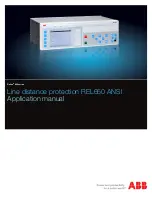
Manual Or Automatic Reset
The overload relay is normally furnished set for “HAND” reset opera-
tion. The relay may be set for either “HAND” or “AUTO” slightly
loosening the reset screw (1), holding the reset plate (2), moving the
plate to the proper position marked on the molded case (away from
the panel for”Hand” reset and toward the panel for”Auto” reset) and
retightening the screw.
(See Figure 1.)
Automatic reset should not be used with 2-wire control circuits
where automatic starting of the motor may be hazardous.
Adjustable Trip
The trip rating of a specific heater element can be adjusted over
a range of approximately 85% to 115%. This is accomplished by
turning the adjustment knob (3) on the top of the relay to the respec-
tive stop position. This to alleviate nuisance tripping; or conversely, to
gain closer protection when desired.
Trip Indication
The Type A overload relay gives an immediate visible indication of
trip. When an overload occurs, which causes the relay to operate, a
trip indicator (5) projects out through a small opening at the bottom
of the relay.
(See Figure 1.)
Ambient Compensation
Ambient compensated OLR’s have substantially the same trip
characteristics for ambient temperatures from -40oC to 75oC (-40oF
to 167oF). Because of a compensating bimetal, which maintains a
constant travel to trip distance independent of ambient conditions,
operation of this bimetallic relay is responsive only to heat generated
by the motor overcurrent passing through the heater element. The
compensating feature is fully automatic and no adjustments are
required over normal fluctuations in ambient temperatures. Overload
relays having ambient compensation can be identified by light gray
reset rods whereas non-compensated overload relays have red reset
rods.
Figure 2. Size 2 overload relay for A200 controller mounting
Figure 3. Overload relay mounted on A200 controller
m
IMPORTANT
DO NOT TAMPER WITH THIS TRIP INDICATOR AS IT IS AN INTEGRAL PART
IN THE CALIBRATION AND TAMPERING THEREWITH MAY CAUSES CHANG-
ES IN TRIP CHARACTERISTICS.
Table 2. Control contact ratings
AC
volts
Normally closed
Normally open
Make
Break
Make
Break
24-120
120-600
20A
2400 VA
2A
240 VA
5A
600 VA
0.5A
60 VA
Table 3. Power circuit terminals
NEMA Size
Wire Size
1
2
#14 - 8 AWG
#14 - 3 AWG
Wire with copper conductors only
Table 4. Recommended driving torque
Location (Qty.)
Driving
Torque
(lb.-in.)
Main Power Connections (6)
Control Connections (2)
Heater Mtg. Screws (2/pole)
18 - 20 (Size 1)
45 - 50 (Size 2)
8 - 9
18 - 20
2
Instruction Leaflet
IL14568
Effective June 2020
Size 1 or 2 Type A Thermal Overload Relay, 3 Pole,
Ambient Compensated or Non-Compensated
EATON
www.eaton.com






















